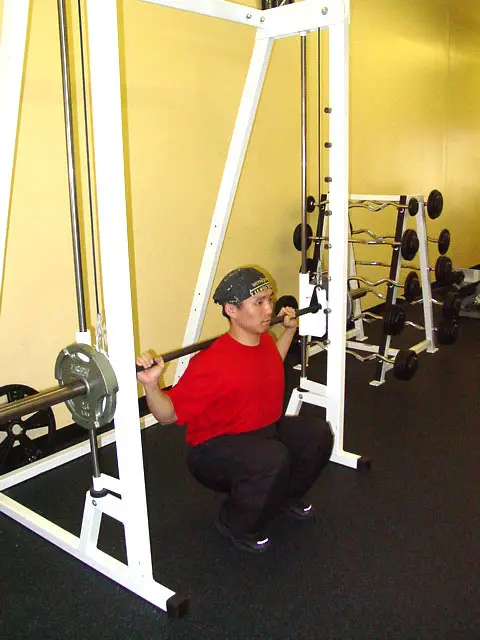The number of sets and reps you do in a weight training exercise should depend on your fitness goals, such as getting stronger, more endurance, or more muscle mass. There’s no one-size-fits-all number for everyone, but research finds an optimal range that you can do to maximize strength gains or muscle hypertrophy.
What is a set and rep?
A rep—or repetition—is the number of times you perform a movement. For example, doing one squat is one rep, and five squats is five reps.
A set is the total number of reps you do. If you complete 10 push-ups, that counts as one set. You would often see the sets and reps written as 3 x 10 or 2 x 6, which means three sets of ten reps or two sets of six reps. In relation to intensity, a lower number of sets with a higher number of reps usually corresponds with lower intensity, and vice versa.
So if you’re aiming for maximum strength, your weight training sets and reps might look like this:
Barbell squats: 5 x 5 or 6 x 3
Bench press: 5 x 5 or 6 x 3
Lat pulldown: 5 x 5 or 6 x 3
And if you’re training for bigger muscles, your workout might look like this:
Barbell squats: 3 x 10 or 3 x 12
Bench press: 3 x 10 or 3 x 12
Lat pulldown: 3 x 10 or 3 x 12
What does research say about how many sets and reps you should do?
A 2017 systematic review may unravel some of the controversy among personal trainers and strength coaches about how many sets and reps you should do to gain maximum strength or hypertrophy. The researchers, led by exercise physiologist Brad Schoenfeld of Lehman College in New York, examined 21 qualified studies and found that lighter loads can increase both strength and muscle hypertrophy as well as heavier loads.
Using one rep max (1RM) as a marker for the percentage of resistance, high-load training is considered to be greater than or equal to 60% of 1RM, and low-load training is anything below 60%. They wrote that both heavy and light loads showed “large effect for 1RM increases” by about 35% and 28%, respectively. However, most of the subjects are mostly “untrained” and may not apply much to experienced weightlifters. Schoenfeld and his colleagues did say that seasoned weightlifters can benefit from high-load training for maximum strength gains.
While this study does not dictate the range of sets and reps of weight training you should do, understanding the exercise intensity can help you find that range. Higher-load training should have lower number of reps than lower loads, yet its number of sets should be higher.
For example, if you are doing a barbell squat at 70%of 1RM, you could do 4–5 sets of 5–8 reps. At 50%of 1RM, you could do 2–3 sets of 10–15 reps.
Volume matters in weight training sets and reps
Training volume refers to the net number of sets and reps per body part or movement pattern that you do. While most exercise expert suggest that higher volume is better to get bigger muscles, a 2022 systematic review of six studies finds that there’s “no differences between moderate and high training volume” for muscle growth. However, the research only looked at training of the quadriceps, biceps brachii, and triceps brachiii, and the triceps seems to respond better to higher volume training “to induce muscle mass gains.”
The amount you train per week over three to six months can affect how much strength and muscle mass you gain. The same research above suggests that 20 or more sets per week per muscle group. However, your body adapts to your workout during that time period, which can lead to a plateau. This is where the exercises get easier to do—which is a good thing—but you would not see much further gains in strength or muscle growth.
To change your workout, one easy way to do so is to adjust the number of sets or reps while keeping the intensity and exercise selections the same. For example, if your goal is muscle hypertrophy and you have been doing 3–4 sets of 8–12 reps at 60% of 1RM, increase the number of reps to 10–14 reps or while decreasing the number of sets to 2–3. Likewise, you can increase the number of sets to 4–5 while decreasing the number of reps to 6–10.
Of course, you can also keep the number of sets and reps the same while increasing the load, reduce or increase resting periods between sets, or change the exercise—as suggested by the FITT principle.
Exercise tempo with sets and reps
Sometimes focusing on sets, reps, and volume aren’t enough. Consider the tempo—or the speed in which you do the exericse. This is where you focus on the concentric and eccentric muscle contractions, which are two primary types of muscle contractions.
For example, when you do bench press, you push the barbell up, which is a concentric contraction of your chest and tricep muscles. When you lower the barbell, your chest and triceps are undergoing eccentric contraction. And if you want to focus on muscle growth, the tempo would be 1–2 seconds up and 3–4 seconds down.
While a 2022 review finds that emphasizing on eccentric contractions is better for overall muscle growth than focusing on concentric contractions, some researchers find that concentric contractions induce muscle hypertrophy in the middle of the muscle body, while eccentric contractions induce growth at the distal ends of a muscle. This might be caused by “possibly due to localized muscle damage along the fiber produced by non-uniform muscle activation of eccentric contractions,” the researchers in the review wrote.
A native of San Diego for nearly 40 years, Nick Ng is an editor of Massage & Fitness Magazine, an online publication for manual therapists and the public who want to explore the science behind touch, pain, and exercise, and how to apply that in their hands-on practice or daily lives.
An alumni from San Diego State University with a B.A. in Graphic Communications, Nick also completed his massage therapy training at International Professional School of Bodywork in San Diego in 2014.
When he is not writing or reading, you would likely find him weightlifting at the gym, salsa dancing, or exploring new areas to walk and eat around Southern California.





